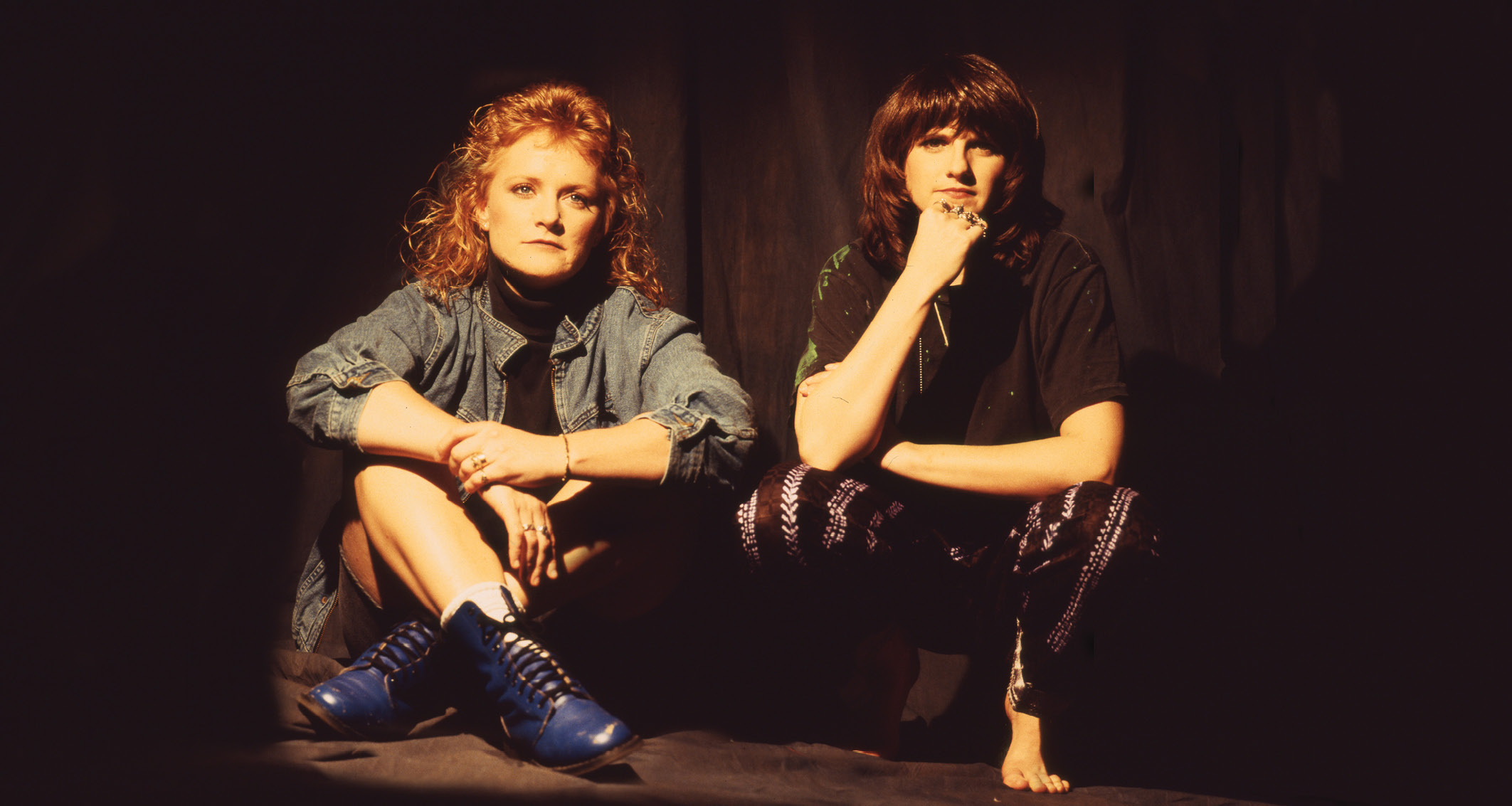
ONE OF THE most powerful revelations in Alexandria Bombach’s new documentary about the multiplatinum, still-touring-and-recording Indigo Girls is the fact that Amy Ray and Emily Saliers met when they were twelve years old. I fucking knew it! I screamed at the screen.
I didn’t know it in the wikipedia sense of knowing, but more so knew it in my bones. I didn’t go to sleepaway camp as a kid, but my BFFs did. And they sent me letters on purple stationary—florid handwriting displays dotted with stickers and acronyms and shibboleths and the first two Indigo Girls albums on dubbed Maxell cassette tapes. To watch the Indigo Girls dubbing Maxell cassette tapes for each other as pre-teens was so affirming that I immediately felt my critical lens dissolve. I panicked. I can’t review this documentary. I just want to like it. I want it to like me back. I want to make a mixtape for it, a friendship bracelet.
I showed up to the screening alone, at home. The friends I would have watched it with are now estranged, but I still mentally patted myself down for them as if they were just misplaced in the wrong pocket. Hello, god? You up? It’s me watching It’s Only Life After All alone. I was watching it wrong—you can’t sing harmony by yourself—but my access to the screener would expire at midnight and I hadn’t yet managed to mend all of my tattered old friendships to the extent that we might spontaneously watch a movie together on a bright summer day and try to sing along in harmony but both end up accidentally taking the high part.
Singing in perfect harmony is really fucking hard. Singing the harmony of an Indigo Girls song together is the kind of communion that people seek in romantic love and religion but is actually available only in deep platonic intimacy. It is a miracle so earthly that I would hate to make it seem ethereal or abstract by calling it a miracle. In the film, when she’s asked to account for her songwriting prowess, Emily says writing music has a mysterious source, deflecting insinuations that she has a special and elite gift. But this is a real magic that real people do, I remind myself. The Indigo Girls blend together, they overlap for the better. The sum is more powerful than its parts.
Alexandria Bombach, the filmmaker, is an award-winning director/editor/nomad known best for the 2018 feature On Her Shoulders, which follows a 23-year-old Yazidi woman who survives genocide, sexual slavery, and ISIS to be shoe-horned into the role of “public face,” called on to attract interest in the plight of her religious minority. For It’s Only Life After All, Bombach favors tight shots of Saliers’ and Ray’s fifty-something-year-old faces. They’re each interviewed solo, in a green chair against a black backdrop. We learn about their families, their big break as a house band at a queer-owned pub, and their activist mentors like Winona LaDuke and Marsha Gomez.
Bombach tells the incredibly true tale of two fully clothed lesbians who never court the male gaze but still end up on MTV sometimes.
Bombach tells the incredibly true tale of two fully clothed lesbians who never court the male gaze but still end up on MTV sometimes. It is also the story of how you can save someone’s life by feeling deeply and singing beautifully. A particularly moving segment is composed of interviews with fans at an outdoor concert who describe how the Indigo Girls and their music gave them courage to become opera singers or be openly gay or not kill themselves in the midst of a brutal divorce. Theirs are skills essential to humanity, not just decorative accessories to the hard edges of existence, but the mechanism for making any meaning out of the edges at all. Fans repeat this narrative of salvation throughout the film, how the Indigo Girls and their songs brought them connection to the world and to other people. It is relational music. It doesn’t just tell you that you’re not alone; it proves that you’re not alone; it holds your hand and keeps you company. That’s the magic trick of singing in harmony. It just won’t be done alone.
As I write this, It’s Only Life After All is not yet streaming or distributed—it’s still on the festival circuit of Tribeca, Sundance, Outfest, etc.—but I found reviews online. They all mention the time in 2005 when the band was mocked on Saturday Night Live as emblems of the flannel-clad patchouli-lesbian-feminist stereotype, unappealing and overserious. But none of the reviews mention Saliers telling the story of when she and her friends were physically attacked by homophobes. Gaybashing, she called it. We don’t use that phrase much anymore, do we? I’m not sure why SNL’s poor attempt at humor is a more notable attack than the physical attack on her existence as a queer person in public, but it apparently is. Much is made, too, of the director’s choice to have the Indigo Girls read aloud a particularly dismissive and venomous review from Jon Pareles of the New York Times. Ray, especially, balances well-earned ill feeling about how they were treated in the industry and by the media with self-awareness; she acknowledges that she did sometimes perform “with stagy self-congratulatory gestures,” as Pareles put it, and that some of the early songs were overwrought. Amy can barely listen to “Blood and Fire” from their first album, but she dings it for its self-absorption, not the honesty of its pain.
Blessedly, the film eschews rock critic pundits theorizing about the Indigo Girl oeuvre and contextualizing away the homophobia and sexism that pelted the two relentlessly. The only talking heads in the documentary, really, are Ray and Saliers themselves, who appear across decades via interviews and Ray’s glorious home movie footage. The effect is that of a legion of Indigo Girls existing simultaneously. Or, to more accurately describe the sensation: of Indigo Girls who seem capable of slipping seamlessly back and forth between their youthful and mature selves. This is undoubtedly the result of things like solid editing of great source material, but I think it is more so an indication of their integrity.
Watching It’s Only Life After All, even alone, is to experience communion. Bombach makes it perfectly clear that the Indigo Girls make you feel like you’re twelve years old and singing with your best friend exactly because that is where their music comes from. They found a way to distill that feeling at its source. They are simultaneously very serious and very goofy and there is no contradiction in it. Maybe that sensation feels unfamiliar or uncomfortable for some, and when people cringe at the sincerity and conviction of their lyrics, I get it. I want to protect myself from being vulnerable and feeling everything, too. Sometimes it’s scary just to watch other people be in touch with real feelings. But it is not an accident if the two make you feel like your most superbly idealistic, most vibrantly feeling self. That’s what the Indigo Girls have always offered without apology.

